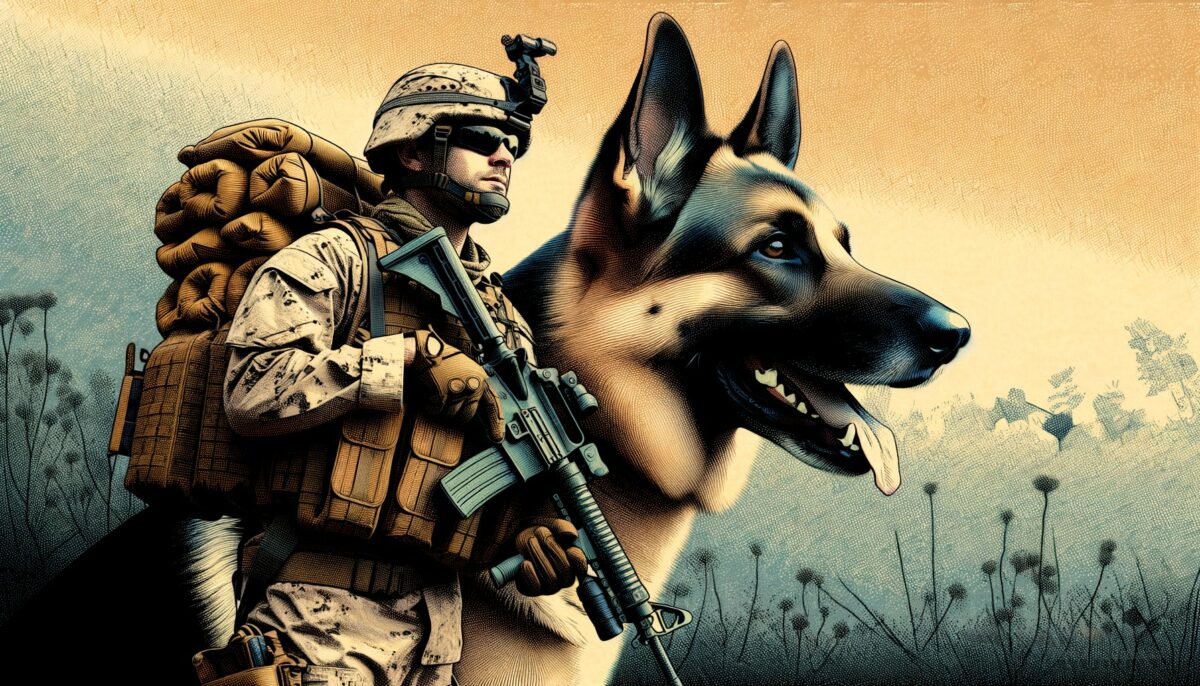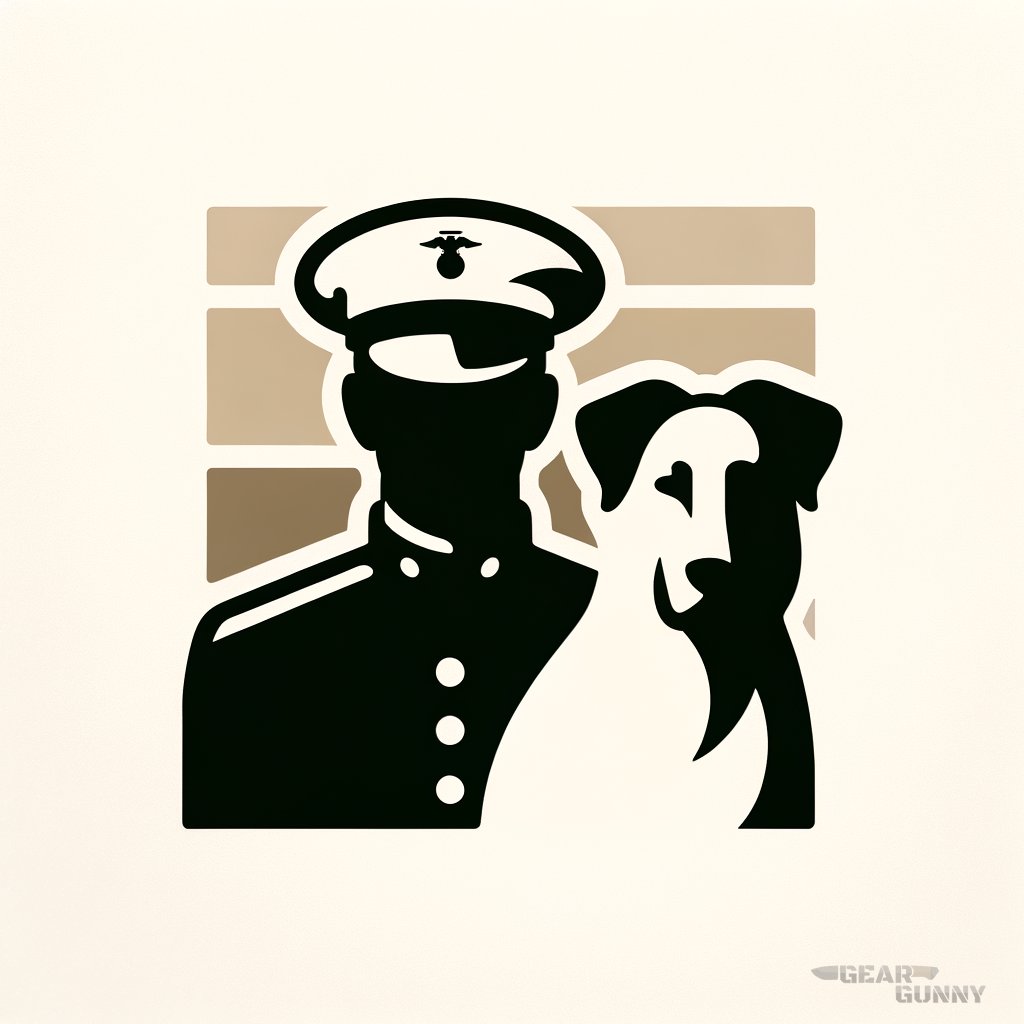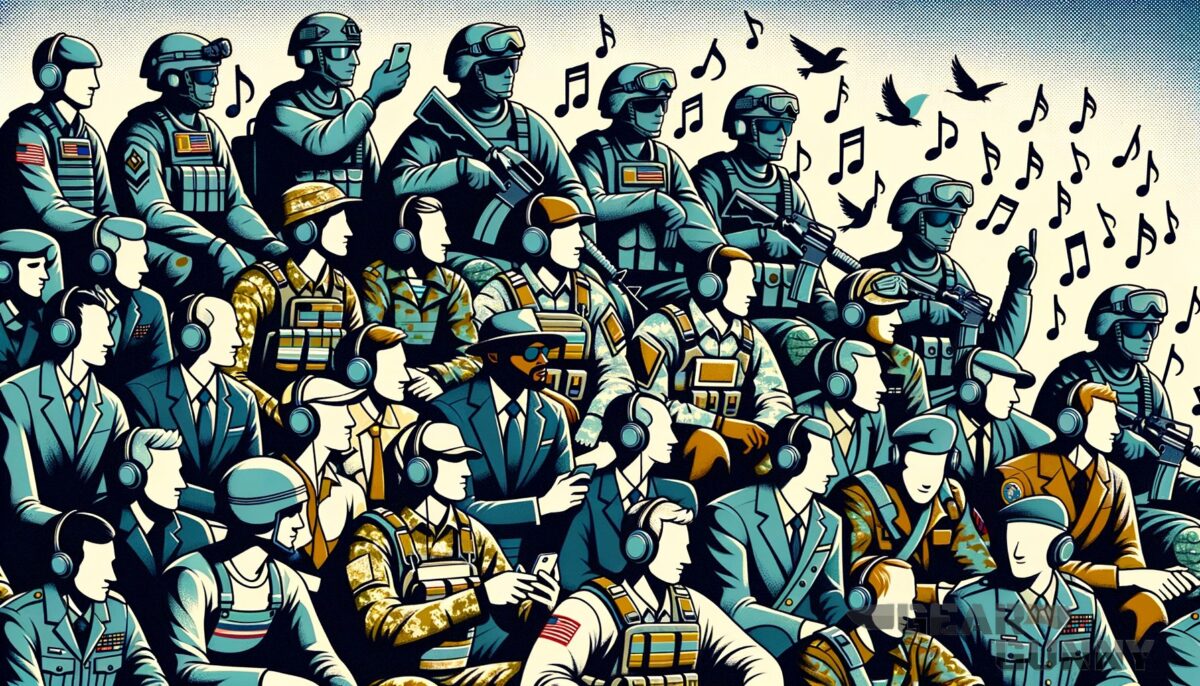Ever wondered if our four-legged friends can stand beside our Marines? Have you considered how dogs might fit into the disciplined world of the Marine Corps? Find out as we dive into the role canines play in military operations, and discover the essential gear that makes a Marine ready for action. In this post, we’ll uncover the specifics about dogs in the Marines and the affect they have on the Corps.
Key takeaways
- Military Working Dogs are essential in the USMC for detection, security, and emotional support.
- Dogs get rigorous training and specialized gear similar to their human counterparts.
- The well-being of canines in service is high priority, with comprehensive care for both physical and emotional health.
Are dogs allowed in the marine corps?
When it comes to the Marine Corps, dogs do indeed have a special place within certain units. As a USMC veteran, I’ve seen first-hand how military working dogs (MWDs) support our troops in various roles. From detection to defense, these pups are an integral part of the service. They go through rigorous training to detect explosives, drugs, and to perform search and rescue missions.

Here’s what you need to know about dogs in the Marine Corps: * Selection and Training: Dogs that serve in the Marines undergo a thorough selection process to ensure they have the right temperament and abilities. Their training is intense, with a focus on obedience, specialized skills, and the ability to work under combat conditions. * Roles and Responsibilities: MWDs can be scout dogs, sentry dogs, or specialized search dogs. They’re crucial in patrol operations, enhancing security, and ensuring troop safety.
* Utilization and Care: The care provided to these dogs parallels the importance of their role. They get high-quality medical attention, nutrition, and gear tailored to their needs, comparable to what a Marine would get.
bolster troop safety with top-tier tactical gear.
In my view as a former Marine, though I’m no expert in the specific training of military working dogs, I’d say their inclusion in the Corps is nothing short of critical. Not only do they enhance operational effectiveness, but they also provide emotional support to Marines in times of stress. The bond between a Marine and a MWD is profound and unlike any other within the military.
While these dogs do not serve in traditional Marine roles, they are outfitted with some of the best tactical gear to suit their unique missions. Their affect within the Corps is undeniable, and I believe their brave service deserves recognition. They truly exemplify the fighting spirit of the Marines in their own right.
learn more about the unwavering Marine Corps spirit.
5.11 Rush 24 Tactical Backpack

5.11 Rush 24 Tactical Backpack
Roles of dogs in the marine corps
The Marine Corps employs highly trained canines in a variety of roles, all essential to mission success. These dogs are not just allowed; they’re regarded as Marines in their own respect, performing critical duties.
Military working dog teams
Marines and their canine counterparts form dynamic teams specialized in security and detection. These dogs carry out various tasks: * Explosive Ordnance Detection * Drug Detection * Patrol and Guard Duties

In navigating the complexities of military operations, canines serve as an unmatched force multiplier. Their roles extend beyond their extraordinary capabilities; they also offer psychological comfort that improves troop morale, making them a valued and integral part of the Marine Corps family.
Their capabilities greatly enhance the Marines’ effectiveness, making them invaluable assets in maintaining operational security.
Training of marine corps canines
Rigorous training is the backbone of a Marine Corps canine’s effectiveness. The process includes: * Basic obedience and socialization * Specialized skill development * Exposure to combat-like scenarios
These dogs graduate as seasoned professionals, equipped to face the challenges of their unique roles. The thoroughness of their training ensures they can operate alongside Marines under the most demanding conditions.
discover the rigor of Marine training.
Importance of canines in the corps
Military Working Dogs are more than tools; they are lifelines for Marines in the field. Their importance can’t be overstated.
Detection and security capabilities
With acute senses, canines excel in detection roles that are beyond human capabilities: * Detection of hidden threats such as IEDs * Recognition of threats to peacekeeping forces * Prevention of harm to Marines and civilians alike
These abilities are critical in maintaining the safety of Marines and ensuring mission accomplishment.
Emotional support and morale
On a different spectrum, these dogs also offer comfort and companionship in high-stress environments: * Reducing stress among troops * Providing comfort during operations * Enhancing overall unit morale
Their presence makes a significant affect, not just on safety but also on the well-being of the Marines they serve.
take a look at the Marine Corps values.
Equipment for marine corps canines
Just like any Marine, these canines are equipped with gear that allows them to carry out their duties effectively.
Specialized tactical gear for canines
The gear ensures safety and efficiency in field operations: * Protective vests designed for canines * Night vision and thermal imaging equipment * Specialized harnesses for rappelling and parachuting
The tactical gear used by these canines matches the demanding nature of their work, safeguarding them while they safeguard humans.
Requirements for canine equipment
The USMC maintains specific standards for canine gear: * Must ensure mobility and comfort * Should withstand varied environmental conditions * Ought to provide adequate protection in hostile situations
The gear plays a crucial role in a military working dog’s operational lifespan and success.
check out essential plate carriers for the USMC.
Medical and emotional care for canines
The well-being of Marine Corps dogs is a high priority. They get top-notch care to ensure their longevity and health.
Veterinary services for military working dogs
- Access to premium healthcare and preventative measures
- Ongoing health monitoring by trained veterinary staff
- Immediate medical attention when injured or ill
These canines are treated with the utmost concern for their physical health and are provided with a quality of care that reflects their valued status in the Corps.
Mental health support
Mental and emotional well-being is equally crucial: * Regular evaluations by behavioral specialists * Rehabilitation and therapy when needed * Retirement plans for after their service is complete
Just as with their human counterparts, the USMC ensures these service dogs are supported throughout and after their careers.
explore the Marine Corps approach to endurance and survival.
Dogs in the Marine Corps Play Significant Roles and are Afforded Equipment, Training, and Care Reflecting Their Importance.
| Canine Role | Training Focus | Equipment Used | Health Care Provided |
|---|---|---|---|
| Detection | Explosives, Narcotics | Protective Vests, Goggles | Preventative Care, Emergency Care |
| Patrol | Obedience, Guard Duties | Communication Devices | Routine Check-Ups, Behavioral Eval |
| Search & Rescue | Agility, Recovery Skills | GPS Trackers, Rappelling Gear | Physical Rehabilitation, Therapy |
More military canine tips
When adding working dogs into military operations, there’s a gamut of considerations to ensure effectiveness and safety. Here’s some guidance to optimize their capabilities and welfare:
- Keep Training Consistent: Regular, ongoing training keeps military canines sharp and ready for any mission.
- Prioritize Compatibility: Pair handlers and dogs based on compatibility for stronger team cohesion and trust.
- Maintain Clear Command Structures: Just like their human counterparts, canines need clear commands and structure to thrive.
- Invest in Quality Gear: Ensure your canines have the best tactical gear appropriate for their role.
- Monitor Health Vigilantly: Regular health checks are crucial to detect issues early and maintain operational readiness.
Properly managed, working dogs can be crucial assets in military operations, bolstering both safety and success.
For those handling military canines, here’s a rundown of important do’s and don’ts:
| Do | Don’t |
|---|---|
| Establish a routine for training and care. | Overwork the canines without adequate rest. |
| Use positive reinforcement techniques. | Neglect the signs of stress or fatigue. |
| Ensure canines are acclimated to gear. | Use gear that hinders movement or comfort. |
| Provide a balanced diet and hydration. | Forgo regular veterinary check-ups. |
| Keep up with the latest canine training methods. | Disregard the dog’s behavioral cues. |
Advantages and disadvantages of military working dogs
Military Working Dogs (MWDs) represent a unique blend of loyalty, discipline, and capability within the armed forces. As they take on roles that are sometimes beyond human capability, their pros and cons come to light.
Advantages
- Heightened Sensory Capabilities: Canines detect what humans might miss.
- Versatility in Roles: They excel in a range of tasks from detection to protection.
- Bond with Handlers: This can improve handler safety and effectiveness.
- Non-lethal Deterrence: Dogs can control situations without the need for force.
- Psychological Comfort: They provide companionship that boosts troop morale.
Disadvantages
- Training and Maintenance: The cost and time invested in preparation are significant.
- Emotional Attachment: The loss of a canine can have a profound affect on handlers.
- Risk of Injury: Dogs in combat zones are susceptible to injury or death.
- Limitations in Environment: Canines may be restricted by extreme climates or terrains.
- Logistical Considerations: Accommodating canines requires more planning and resources.
Navigating these pros and cons is crucial for maximizing the effectiveness of MWDs while maintaining their welfare.
If you are a visual learner, check out this video titled ‘Milsim Loadout – Beginner’
Frequently asked questions (FAQ)
How are military working dogs cared for after retirement?
Once a military working dog retires, they are usually adopted by their handler or other loving homes. The transition from active service to domestic life is supported by the military, ensuring the well-being of these courageous animals who have dedicated their lives to service.
Can civilian dogs be donated to the marine corps?
While the Marine Corps typically sources dogs from specific breeders or military programs, civilian donations are sometimes accepted if the dog meets strict criteria regarding health, temperament, and trainability. Each potential donation is evaluated on a case-by-case basis.
Are there specific breeds that the marine corps prefers for their canine units?
The Marine Corps commonly utilizes breeds known for their working abilities, such as German Shepherds, Belgian Malinois, and Labrador Retrievers. These breeds are chosen for their intelligence, strength, and adaptability to the demanding requirements of military work.
Final thoughts
As we wrap up the conversation about dogs in the Marine Corps, it’s clear that they are more than just pets or mascots—they are highly trained professionals integral to military operations. Their unwavering service, remarkable capabilities, and the strong bonds they forge with their handlers solidify their status as invaluable members of the Corps.
Did I cover everything you wanted to know?I read and reply to every comment. If you found this article helpful, share it with a friend, and check out my full blog for more tips and tricks on tactical military techniques and equipment. Thanks for reading and stay sharp out there, devil dogs!















